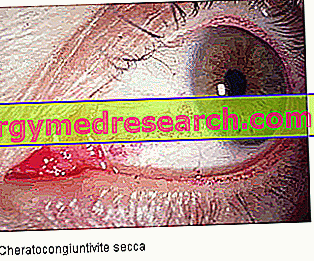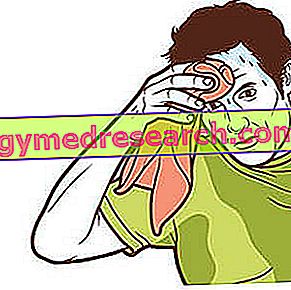Definition
Keratoconjunctivitis is a pathological condition characterized by the simultaneous inflammation of the cornea (keratitis) and conjunctiva (conjunctivitis).
There are different sub-categories of keratoconjunctivitis, essentially distinguished on the basis of the causal agent and the symptoms with which they occur.
The most common forms of corneal and conjunctival inflammation are:
- Dry keratoconjunctivitis (or dry eye syndrome)
- Epidemic keratoconjunctivitis (from Adenovirus)
- Spring keratoconjunctivitis (or vernal)
Dry keratoconjunctivitis
Typical of the elderly and middle-aged women, dry keratoconjunctivitis is a common cause of eye irritation, which originates in all conditions characterized by an alteration of the lacrimal secretory processes.

SYMPTOMS
Also known as dry eye syndrome, dry keratoconjunctivitis causes pain and burning eyes, often associated with ocular hyperaemia (red eyes), photophobia (light intolerance), blurred vision and difficulty wearing contact lenses.
In some affected patients, the appearance of stringy mucus in or around the eye is also observed. In severe cases, dry keratoconjunctivitis can degenerate up to the formation of corneal ulcers: in similar situations, the affected patient risks corneal perforation and extensive eye infections.
To learn more: Symptoms Dry eye syndrome
CAUSES
The typical dry eye that accompanies this form of keratoconjunctivitis may be associated with serious pathologies such as Sjögren's syndrome *, or may represent the complication of allergic conjunctivitis * and blepharitis *. Even some unsuitable behavioral habits may constitute possible risk factors for dry keratoconjunctivitis: in some patients, in fact, the typical symptoms of dry eye syndrome occur precisely because of poor environmental humidity. For this reason, air conditioners and convectors must be used with moderation and caution.
* Glossary
- Sjögren syndrome: complex autoimmune disorder that is distinguished by the destruction of lacrimal glands and other exocrine glands
- Allergic conjunctivitis: inflammation of the conjunctiva induced by an allergen (eg pollen, contact lenses, etc.)
- Blepharitis: general inflammation of the eyelid
THERAPY
Treatment for dry keratitis depends on the nature of the inflammation. When the cause lies in bacterial infections (supported for example by streptococcus), the most indicated drugs are topical antibiotics, to be instilled in the eye in the form of eye drops. In the case of dry keratoconjunctivitis related to allergies, the antihistamine eye drops can remove the symptoms such as ocular burning and itching.
When dry eyes simply depend on low environmental humidity, artificial tears can undoubtedly improve symptoms: in this case, the use of an ambient humidifier is recommended.
Epidemic keratoconjunctivitis
CAUSES
This form of corneal and conjunctival inflammation is mainly caused by an infection supported by Adenovirus, the same pathogens involved in most viral infections of the respiratory tract (eg tonsillitis, colds, pneumonia and pharyngitis).
SYMPTOMS
Adenovirus keratoconjunctivitis begins suddenly with characteristic symptoms, such as:
- Acute follicular conjunctivitis
- iperlacrimazione
- Strong eye redness
- Enlargement of preauricular lymph nodes
- Inflammation of the cornea (keratitis)
- Chemosis (conjunctival edema)
Viral keratoconjunctivitis may be preceded by typically flu-like symptoms, such as fever, general malaise, nausea, vomiting and diarrhea.

THERAPY
The cure for epidemic keratoconjunctivitis is generally symptomatic, ie aimed exclusively at treating symptoms. Artificial tears and analgesic eye drops are particularly indicated to alleviate symptoms; even cold packs to be applied directly on the eyelids can bring immediate relief and favor ocular decongestion.
In the most serious cases, the doctor may prescribe antiviral eye drops or ophthalmic ointments. Topical corticosteroids are reserved for cases of extreme severity; it is recommended to avoid self-treatment and always seek medical advice before taking any type of medication.
Vernal keratoconjunctivitis
The so-called "vernal" keratoconjunctivitis is a type of corneal and conjunctival inflammation that recurs with a seasonal incidence. Literally, "vernal" means spring, a term used to indicate the onset of symptoms (not surprisingly, this type of inflammation is also known as spring keratoconjunctivitis ).
CAUSES

SYMPTOMS
Being of an allergic nature, spring keratoconjunctivitis manifests itself with typical symptoms, such as tearing, burning, perception of a foreign body in the eye, photophobia, ocular itching and red eyes. In some cases, this disorder can promote the appearance of painful corneal ulcers.
The symptoms begin before the arrival of spring and are accentuated during the summer period, to then slowly decline in the autumn and winter months.
Ocular inflammation is aggravated by dust, smoke, smog and wind.
THERAPY
Antihistamine treatment for vernal keratoconjunctivitis is essential for controlling symptoms and preventing exacerbations of the disorder. Some patients resort to topical application of cortisone eye drops, which can determine a powerful anti-inflammatory action at the cornea and conjunctiva level. Analgesic eye drops are sometimes sufficient to calm the discomfort and burning in the eyes of a medium-moderate size.
Other types of keratoconjunctivitis
In addition to the variants of keratoconjunctivitis described above, there are other forms of corneal and conjunctival inflammation, which however tend to occur less frequently:
- ATOPIC KERATOCONGIUNTIVITE: fortunately rare, this type of conjunctival and corneal inflammation tends to occur mainly in young adults. Although the cause still remains an unresolved issue, a certain correlation has been observed between atopic keratoconjunctivitis and some disorders, such as in particular: eczema, asthma and atopic dermatitis. The clinical picture of atopic conjunctivitis is characterized by the appearance of symptoms such as inflammation of the cornea and conjunctiva, itching, abundant tearing, photophobia, alteration of vision, burning and mucous and stringy ocular secretions. As can be seen, the symptoms with which this form of keratoconjunctivitis manifests are common to many other forms of ocular inflammation: for this reason, the diagnostic assessment - rather complex - is indispensable. The most indicated drugs to reduce the obvious inflammation are topical corticosteroids, which must however be used with moderation and common sense. In the presence of corneal lesions, it is recommended to apply ophthalmic ointments with a skin restoring action (eg prepared with hyaluronic acid).
- GIGANTOPAPILLANT CHERTOCONGIUNTIVITE: It is a disorder typical of contact lens wearers. In sensitive subjects, the frequent use of contact lenses or the incorrect application of the same can cause ocular inflammation, which translates precisely into keratoconjunctivitis. Even asthmatic patients suffering from hay fever or who have a certain sensitivity to allergens of animal origin have a rather high risk of developing gigantopapillary keratoconjunctivitis. The disorder manifests itself with ocular redness, conjunctival and corneal irritation, itching and blurred vision. In some cases, this condition can cause corneal ulcers. The first trick to consider in the presence of gigantopapillary keratoconjunctivitis is to replace contact lenses with eyeglasses to avoid damaging the conjunctiva and the cornea even more.



